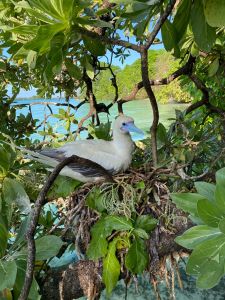PI-CASC researchers look at seabird, human waste impacts on coral reef health

Specifically, researchers Megan Donahue and Jessica Glazner are investigating the different impacts seabird guano and wastewater effluent have on the health and perseverance of corals. In doing so, the team hopes the project will shed light on how natural nutrient sources influence reef resilience on remote atolls, such as Palmyra Atoll, compared to how human waste pollution is affecting reefs near populated islands. Donahue and Glazner will also be testing if the beneficial aspects of seabird guano can be replicated in areas where it is not prevalent due to a decline in seabird populations.
This project comes at a time where the State of Hawaiʻi is transitioning to a new form of waste and wastewater management.
“On populated islands, wastewater treatment and disposal are typically a major issue. In Hawaiʻi, where this research is being conducted, a recent law was passed to convert all cesspools to another form of wastewater disposal by 2050. Therefore, our project is highly relevant to help the community understand why it is so important that these conversions happen,” according to the duo.
Coral reefs near populated islands are losing coral cover at a significantly higher rate than coral reefs near remote islands due to thermal stress, partially because of local stressors like nutrient pollution, Glazner said. With rising ocean temperatures exacerbating the loss, there is an urgent need to explore management actions that support coral reefs’ persistence through global climate change, and this project addresses knowledge gaps that could bolster reef resilience.
Investigating differences in nutrient sources

This summer, the team will be conducting a tank experiment to see how corals respond to seabird guano and wastewater effluent during a simulated thermal stress event. Coral health and response will be measured to gauge the effects of both subsidies. So far, Donahue and Glazner have collected guano for analysis and have come to discover interesting early findings.
“The preliminary results of the nutrient content of guano and wastewater effluent show that the two nutrient sources have very different nutrient compositions. Guano is high in ammonium and phosphate, but low in nitrate, whereas wastewater effluent is high in nitrate, but low in ammonium and phosphate. Based on results from previous research, these differences could play a major role in why the two nutrient sources have such contrasting effects on coral health and their stress response,” the team stated.

To collect seabird guano, Donahue and Glazner recently spent a week at the Climate Adaptation and Resilience Lab on Palmyra Atoll. The atoll is home to the second largest red-footed booby colony on the planet. Their guano was collected from branches and leaves under their nests and roosting sites. The team also collected seawater, coral, and algae samples that will be analyzed to determine if the guano is more concentrated near the islets where the seabird density is highest, and how that might affect the adjacent reefs.
This endeavor was inspired by the native forest restoration currently being conducted at Palmyra, where cultivated coconut palms are being removed and replaced by native rainforest tree species. The seabirds prefer to nest and roost in the native tree species, so there are significantly more seabirds in the native forest stands than the coconut palm stands.
“Managers are interested in how native forest restoration is impacting the adjacent coral reefs through the additional nutrient subsidies caused by the return of seabirds to these areas. Our study aims to understand the extent that guano is influencing the coral reefs on Palmyra Atoll’s reef flats and managers can use this information to inform their rainforest restoration management decisions,” the team stated.

